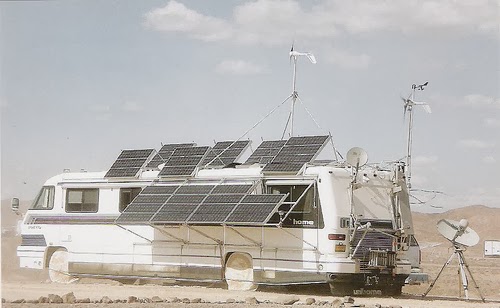 If you are one of those RV'ers that likes the idea of free electricity and living off the grid, I am sure you have begun investigating the various solar options available. I'll admit when I first began to see solar move into the RV industry, I was lost. It seemed as though many companies made it appear like solar was so advanced that only a rocket scientist could configure a system. But after sitting down with some of the solar manufacturers that we supply products for, the fog lifted and I could see this really is not as difficult as some would have you believe. Although, there are many factors that need to be determined when configuring a system, and this is often where most people get tripped up.
If you are one of those RV'ers that likes the idea of free electricity and living off the grid, I am sure you have begun investigating the various solar options available. I'll admit when I first began to see solar move into the RV industry, I was lost. It seemed as though many companies made it appear like solar was so advanced that only a rocket scientist could configure a system. But after sitting down with some of the solar manufacturers that we supply products for, the fog lifted and I could see this really is not as difficult as some would have you believe. Although, there are many factors that need to be determined when configuring a system, and this is often where most people get tripped up.
So where to begin? Usually the first question RV'ers ask when they are looking into solar is "how many panels do I need to power my RV?" Once it's realized that the solar panels don't power the RV, but battery(s) do, there is usually a split in the type of solar user one becomes. With such factors as the amount of power that will be used, for how long between charging cycles and how any batteries there are to hold that power, conserving energy in your RV gained new meaning. There are a number of sites with calculators to help you figure this out such as this one from Salmex Solar. Usually after that wake up call RV'ers look for something a little more simple to possibly just maintain their batteries while the RV is not in use or short weekend boon-docking trips. And with the advent of portable solar systems this and other smaller charging jobs just became a whole lot easier. Here are a few portable rv solar systems that you’ll want to get familiar with before this years camping season begins.
Nowadays, portable solar panels are capable of generating a voltage range that is rather impressive. Take the Go Power! PSK-120 for instance. Made with mono-crystalline solar cells and a 10/A PWM, it will efficiently produce 120 watts. That’s equivalent to 18 DC volts or 21.6 open circuit voltage. For most campers, that should be enough voltage to recharge a 12-volt, deep-cycle battery or a 6-volt golf
cart battery. This system is compatible with flooded, sealed AGM and gel batteries and comes with load control setting features and status indicators. Thus, compatibility and over charge problems won’t need to be a concern.
Nowadays, portable solar panels are capable of generating a voltage range that is rather impressive. Take the Go Power! PSK-120 for instance. Made with mono-crystalline solar cells and a 10/A PWM, it will efficiently produce 120 watts. That’s equivalent to 18 DC volts or 21.6 open circuit voltage. For most campers, that should be enough voltage to recharge a 12-volt, deep-cycle battery or a 6-volt golf
cart battery. This system is compatible with flooded, sealed AGM and gel batteries and comes with load control setting features and status indicators. Thus, compatibility and over charge problems won’t need to be a concern.
 Set-up and storage are worry-free endeavors too. The camping trailer accessory is just 19.9 inches wide, 2.8 inches deep and 32.5 inches tall when closed. And it fits into a durable carrying case that can hold all of the set-up essentials. As such, in most instances, set-up will take you less than 10 minutes from start to finish.
Set-up and storage are worry-free endeavors too. The camping trailer accessory is just 19.9 inches wide, 2.8 inches deep and 32.5 inches tall when closed. And it fits into a durable carrying case that can hold all of the set-up essentials. As such, in most instances, set-up will take you less than 10 minutes from start to finish.
The PSK-120 isn’t the only portable solar panel kit available on the market today. There is also the Nature Power Portable folding systems as well as Samlex portable systems. To learn more about these portable solar panel kits and other green energy powered camping trailer accessories, please contact us at (866) 332-7881. We can help you choose from a wide variety of solar options including trickle chargers, battery bank charging stations, awning lights, flagpole globes and much more.



No comments:
Post a Comment